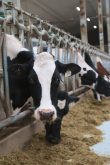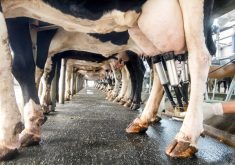Updated, Jan. 15, 2018 –– Dairy Farmers of Ontario expects it will need six per cent more milk from producers in the next year.
DFO chair Ralph Dietrich told the organization’s annual meeting that new processing capacity coming online this year will help drive the continued increase in quota allocated to meet the demand.
The six per cent is in addition to 10 per cent in the past year and more than 20 per cent over the past three years.
Read Also

U.S. livestock: Cattle strength continues
Cattle futures on the Chicago Mercantile Exchange were stronger on Friday, hitting fresh highs to end the week.
The increase will not be coming soon, however, as the P5 quota committee — made up of representatives of the five largest eastern Canada milk-producing provinces — said after its meeting Jan. 11-12 that there wasn’t enough information yet to announce an increase in quota.
The growth in milk demand has occurred since the implementation of a new class of milk, Class 7, priced to compete with imports. The growth in milk has resulted in a building boom for dairy farms, with farmers having to wait about two years before they can get a barn built.
The challenge for dairy farmers is that the price they are paid for Class 7 milk is lower than other classes, meaning the overall blend price of milk has been trending lower.
“We know we need more milk in the system because of processing plants being built,” said Dietrich, including a baby formula plant being built by a Chinese company.
There have been hundreds of millions of dollars in investment in dairy processing announced in Canada over the past year, including to dry skim milk into powder. Dietrich said he’s expecting another announcement in January from Agropur in Eastern Canada about more new processing construction.
Continuing to grow the milk supply as it is needed is the farmers’ part in the supply management deal.
“Our system works best when we can get right amount of milk to the right place at the right time,” said Dietrich. “This is the essence of the Canadian dairy system. Producers, processors and consumers all win.”
So far, farmers have delivered on the needed milk, but balancing the market is an ongoing challenge. Unlike an assembly line where you can step up production quickly when needed, adding more cows can be a two-year process, although a lot of farmers buy cows when needed. If new facilities are needed, it can take a couple of years to get them built.
That’s why there is more emphasis on letting producers know when milk will be needed longer-term.
“What we want to do is give as much, and as soon as we can, direction to farmers as to what will be needed and when,” said Dietrich during an interview.
The P5 — the five eastern provinces, which have a common milk pool — discussed this issue at a recent meeting.
“Something Quebec has done and Ontario and the P5 are doing is to get a handle on what the potential is for increased production among our producers,” said Dietrich. “It’s a good worry to have.”
As some farmers have had their quota holdings grow, but aren’t interested in, or able to fill that quota, and other dairy farmers still look for more quota, there’s more talk about whether it makes sense for some farmers to be able to share their unused quota, usually in the form of a lease.
Many dairy farmers are selling their extra quota on the quota exchange, but others might like to be able to keep access to their quota in case they need it in the future. Dietrich says over the past several months there have been more than 100 producers on the Ontario quota exchange selling portions of their quota.
“The word ‘leasing’ has come up in discussions. The P5 quota committee is looking at ways they can somehow get the quota in the hands of the producers who can fill it. Despite the fact we’re short of milk, we still have producers who have too much milk (for their quota holdings).”
Policy changes, such as leasing, will have to go back to producers, he said, and he expects the organization’s spring policy meetings will have leasing as a discussion topic.
— John Greig is a field editor for Glacier FarmMedia based at Ailsa Craig, Ont. Follow him at @jgreig on Twitter.















